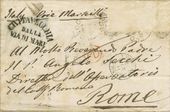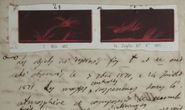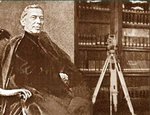Angelo Secchi Project
| Correspondence | Works | Bibliography | |
|---|---|---|---|
The Angelo Secchi collection between science and religion
Slow times of the archives have nothing to do with the speed of our times. Highly complex societies, like ours, demonstrate a growing interest in acceleration, unlike the society of the ancien régime that praised the art of prudence, which presupposed a slow and active perception of time. The speeding-up, while generating shock and stress, is often seen as a value (thus a necessary issue) in the decision-making processes, in the establishment of the diagnosis, in obtaining results, in the movements, etc.
The archives' possibilities to exist in our time are slim considering that the archives require a long time to achieve results. Over the past decade, the almost non-existent requirement for material on Angelo Secchi would seem to confirm this hypothesis.
Besides these epochal conditions affecting the archives, in the case of Angelo Secchi's Fund, there is a huge amount of documentation. To that effect, we want to promote a type of search that avoid considering the Archives as a kind of supermarket of information, that is an accomplice of information overload, which normally does not generate knowledge but rather complexity: no information, since no selection is applied, thus precluding the possibility to establish connections and comparisons. Knowledge, in this case, means the ability to describe starting from differences and distinctions.
For this reason we want to draw a "Angelo Secchi" project, as search program that allows us to select the information to address some problems, namely describing them more adequately. For example, considering the debate "Science/Religion" - sometimes confused as "Faith/Science"- not as a simple opposition between alternatives where the truth could dwell, but as functional positions within the same social system. Any historiographical operation, also the one intended for the production of the so-called "history of science", could not be achieved if detached from a theory of society, as documentation is always contextualized documentation, that is produced by a society in a given age. Often the problem is that the description of the society - and therefore also the historiography that the same produces - focuses on categories that come from the classic European tradition, generated and suited to the enlightenment. Being made in times of reduced complexity, these categories do not respond to the needs and the urgencies of a social system as ours, which is enormously specialized and differentiated.
This research approach starts from a theory of differentiation which considers the documentation as the production of a given social system, and not of an individual (Angelo Secchi), which equates to consider Angelo Secchi as a "socialized person". This issue assumes that society is composed of communications and not by individuals, that is why this research project intends to observe communication, exercising on it an observation, known as second order observation, under which it is possible locating the latencies that contemporaries were unable to observe.
A careful choice of documentation may help describe the social system with which the person Angelo Secchi interacted; that society was evolving from a society based on a hierarchical differentiation towards a society where primary differentiation became functional. In this type of social system an utterance belongs to the scientific system when it is falsifiable (Karl Popper), that is to say when it is possible to submit it to the criteria of verifiability. This implies that there are statements that cannot be judged starting from the distinction truth/falsity, therefore non-scientific statements.
This issue indicates a functionally differentiated society, namely, where various systems (science, law, art, religion) interact. They refer to the society only through their function in relation to it. The person, in principle, is included in all of these subsystems but its interaction (and communication) shall depend on them. In what concerns the science system, its delimitation is constituted starting from the binary code truth/non-truth. To apply this code, there is a need for a program which is consists of a theory and a methodology. The methodology characterizes the internal procedures of science (the modes of falsifiability) and the theory in turn builds the "real" that is observed (the empirical). In this functionally differentiated social system, the religious system does not work within the science system (nor science in the religious or moral system), since the binary code from which its demarcation (operational closure) is carried out is transcendence/immanence. The documentation of the Secchi's Fund could be considered as the production of a time when both the science and the religion systems were taking shape.
In the transition (and the documentation produced by Angelo Secchi is an example of this) from a social system with layered differentiation (such as that of the ancien régime) to one which is characterized by functional differentiation, there is the implementation of fundamental changes, and that is what we would be interested to observe. Communication, as evidenced by documentation, is no longer governed by a hierarchy, while leading to differential systems in light of their specific functions. The increasing complexity of modern society is caused by the takeover, by partial systems of society, of the production and selection of the communication. If the structure changes, the structure of the communication (the semantics) will change too. Following the change of semantics (as cultural heritage of a system) is one of the possible other avenues of pursuit.
Corrispondenti da caricare
NOTE di Ileana CHINNICI
Abetti, Antonio (-)
Aguilar, Antonio (20 lettere caricate)
Antonelli, card. Giacomo
Amici, Giovanni Battista
Arcimis, Augusto T.
Buys Ballot, Christophorus (11 lettere caricate)
Baranowski
Baxendell (Joseph Baxendell 1815–1887)
Rayet Georges (in Phillips c'è un Bayet e un Rayet Y. che forse sono la stessa persona)
Bellavitis, Giusto
Bertelli, Timoteo
Birmingham, John
Blaserna, Pietro
Boncompagni, Baldassarre (23 lettere caricate)
Brassart, E. (Emilio o Ermanno, controllare)
Bredichin, Theodor
Browning, John
Bulard, Charles
Caldarera, Francesco (in Phillips compare come Calilarera)
Cacciatore, Gaetano
Calandrelli, Ignazio (47 lettere caricate)
Cantoni, Giovanni
Carpenter, James
Carrington, Richard Christopher (8 lettere caricate)
Chacornac, Jean
Chambers, George F.
Cialdi, Alessandro (34 lettere caricate)
Cipolletti, Domenico
Coggia, Jéro^me
Colla, Antonio
Cornoldi, Giovanni Maria
Coumbary, Aristides
D'Alcantara, Pedro
D'Abbadie, Antoine (9 lettere caricate)
Dallmeyer, John Henry (6 lettere caricate)
De Bosis, Francesco (in Phillips compare come De Bous)
De Beaumont, Elie
Delisa, Giuseppe (in Phillips compare come prima Dedisa e poi come De Lisa)
De Gasparis, Annibale (39 lettere caricate)
De Gregori Mozzo, Nilo
De la Rove, Auguste
De la Rue, Warren
Denza, Francesco
De Rossi, Michele Stefano
De Vivenot, Rudolf (in Phillips compare come De Vevenot)
Diamilla Müller, Demetrio Emilio (20 lettere caricate)
Donati, Giovan Battista
Draper, Henry
Ertel, T.
Konkoly (von), Nicholas (in Phillips compare come Di Konkoly)
Marié Davy, Hyppolite (in Phillips compare come Davy)
Corrispondenti da completare
Carlo Lavaggi (metadati + trascrizione)
Institutional Partners
University of Notre Dame, Rome Global Gateway:
September-November 2020:
- Maria Semersheim
December 2020-January 2021:
- Paige Haeflinger
- Natalie Modugno
- Alina Peterson
June 2021-July 2021:
- Alina Peterson
- Nicholas Clarizio
Collaborators
- Dr. Ileana Chinnici, Research Astronomer (INAF-Osservatorio Astronomico di Palermo)
- Dr. Christina Graney, Indipendent Research
to request an account, please fill this form.
External links
Entry by Ileana Chinnici Angelo Secchi in in Dizionario Biografico degli Italiani - Volume 91 (2018)
Copyrights
Unless otherwise indicated, all files and contributions (transcriptions, pages, comments) uploaded and submitted to GATE by administrators and users are considered to be released under the Creative Commons Attribution-NonCommercial-NoDerivatives 4.0 International License. All the rights on the images of the manuscripts or other documentation are property of the Historical Archives of the Pontifical Gregorian University (User:ArchivesPUG). If you need high resolution images for your publications or for other usages, please contact us using this form.Your contributions to GATE must be original or, at most, copied from public domain or similar free sources. Remember to always cite your sources and, more important, do not submit copyrighted work without permission.
Report any abuses to the project administrators, using this form.
Acknowledgements
This page has been written thanks to Ileana Chinnici's kindness and broad knowledge about Angelo Secchi.



